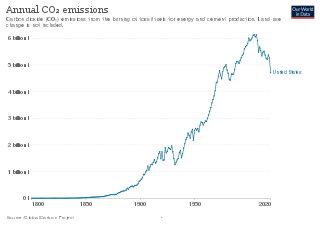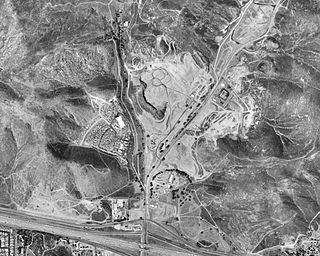
Hazardous waste is waste that must be handled properly to avoid damaging human health or the environment. Waste can be hazardous because it is toxic, reacts violently with other chemicals, or is corrosive, among other traits. As of 2022, humanity produces 300-500 million metric tons of hazardous waste annually. Some common examples are electronics, batteries, and paints. An important aspect of managing hazardous waste is safe disposal. Hazardous waste can be stored in hazardous waste landfills, burned, or recycled into something new. Managing hazardous waste is important to achieve worldwide sustainability. Hazardous waste is regulated on national scale by national governments as well as on an international scale by the United Nations (UN) and international treaties.

The Environmental Protection Agency (EPA) is an independent agency of the United States government tasked with environmental protection matters. President Richard Nixon proposed the establishment of EPA on July 9, 1970; it began operation on December 2, 1970, after Nixon signed an executive order. The order establishing the EPA was ratified by committee hearings in the House and Senate.

Industrial waste is the waste produced by industrial activity which includes any material that is rendered useless during a manufacturing process such as that of factories, mills, and mining operations. Types of industrial waste include dirt and gravel, masonry and concrete, scrap metal, oil, solvents, chemicals, scrap lumber, even vegetable matter from restaurants. Industrial waste may be solid, semi-solid or liquid in form. It may be hazardous waste or non-hazardous waste. Industrial waste may pollute the nearby soil or adjacent water bodies, and can contaminate groundwater, lakes, streams, rivers or coastal waters. Industrial waste is often mixed into municipal waste, making accurate assessments difficult. An estimate for the US goes as high as 7.6 billion tons of industrial waste produced annually, as of 2017. Most countries have enacted legislation to deal with the problem of industrial waste, but strictness and compliance regimes vary. Enforcement is always an issue.

Toxic waste is any unwanted material in all forms that can cause harm. Mostly generated by industry, consumer products like televisions, computers, and phones contain toxic chemicals that can pollute the air and contaminate soil and water. Disposing of such waste is a major public health issue.

Superfund is a United States federal environmental remediation program established by the Comprehensive Environmental Response, Compensation, and Liability Act of 1980 (CERCLA). The program is administered by the Environmental Protection Agency (EPA). The program is designed to investigate and clean up sites contaminated with hazardous substances. Sites managed under this program are referred to as Superfund sites. Of all the sites selected for possible action under this program, 1178 remain on the National Priorities List (NPL) that makes them eligible for cleanup under the Superfund program. Sites on the NPL are considered the most highly contaminated and undergo longer-term remedial investigation and remedial action (cleanups). The state of New Jersey, the fifth smallest state in the U.S., is the location of about ten percent of the priority Superfund sites, a disproportionate amount.

The Resource Conservation and Recovery Act (RCRA), enacted in 1976, is the principal federal law in the United States governing the disposal of solid waste and hazardous waste.

The National Priorities List (NPL) is the priority list of hazardous waste sites in the United States eligible for long-term remedial investigation and remedial action (cleanup) financed under the federal Superfund program. Environmental Protection Agency (EPA) regulations outline a formal process for assessing hazardous waste sites and placing them on the NPL. The NPL is intended primarily to guide EPA in determining which sites are so contaminated as to warrant further investigation and significant cleanup.
Rita Marie Lavelle is a United States and California State Republican political figure. In 1984, Lavelle was convicted on federal charges of perjury related to an investigation into misuse of the United States Environmental Protection Agency's "Superfund" money during her tenure with the agency, and irregularities at the Stringfellow Acid Pits, a major hazardous waste site. The Lavelle incident was labeled "Sewergate" or "Garbagegate" by the newspapers at the time.
Hazardous Waste Operations and Emergency Response is a set of guidelines produced and maintained by the Occupational Safety and Health Administration which regulates hazardous waste operations and emergency services in the United States and its territories. With these guidelines, the U.S. government regulates hazardous wastes and dangerous goods from inception to disposal.

Lisa Perez Jackson is an American chemical engineer who served as the administrator of the United States Environmental Protection Agency (EPA) from 2009 to 2013. She was the first African American to hold that position.

The Illinois Environmental Protection Agency of the state of Illinois is the primary body concerned with the protection of the environment for the state. The Illinois EPA's mission is "to safeguard environmental quality, consistent with the social and economic needs of the State, so as to protect health, welfare, property and the quality of life."
Diamond Alkali Company was an American chemical company incorporated in 1910 in West Virginia by a group of glass industry businessmen from Pittsburgh. The company soon established a large chemical plant at Fairport Harbor, Ohio, which would operate for over sixty years. In 1947, the headquarters of the company was moved from Pittsburgh to Cleveland. Later the company established a plant in Redwood City, California, that produced ion-exchange resins. In 1967, Diamond Alkali and Shamrock Oil and Gas merged to form the Diamond Shamrock Corporation. Diamond Shamrock would go on to merge with Ultramar Corporation, and the combined company, Ultramar Diamond Shamrock Corporation, would in turn be acquired by Valero Energy Corporation in 2001.

The environmental policy of the United States is a federal governmental action to regulate activities that have an environmental impact in the United States. The goal of environmental policy is to protect the environment for future generations while interfering as little as possible with the efficiency of commerce or the liberty of the people and to limit inequity in who is burdened with environmental costs. As his first official act bringing in the 1970s, President Richard Nixon signed the U.S. National Environmental Policy Act (NEPA) into law on New Years Day, 1970. Also in the same year, America began celebrating Earth Day, which has been called "the big bang of U.S. environmental politics, launching the country on a sweeping social learning curve about ecological management never before experienced or attempted in any other nation." NEPA established a comprehensive US national environmental policy and created the requirement to prepare an environmental impact statement for “major federal actions significantly affecting the quality of the environment.” Author and consultant Charles H. Eccleston has called NEPA the world's “environmental Magna Carta”.

The Office of Enforcement and Compliance Assurance (OECA) is the law enforcement arm of the United States Environmental Protection Agency (EPA). It is made up of attorneys, special agents, scientists and other employees.

An ash pond, also called a coal ash basin or surface impoundment, is an engineered structure used at coal-fired power stations for the disposal of two types of coal combustion products: bottom ash and fly ash. The pond is used as a landfill to prevent the release of ash into the atmosphere. Although the use of ash ponds in combination with air pollution controls decreases the amount of airborne pollutants, the structures pose serious health risks for the surrounding environment.

The Stringfellow Acid Pits are a toxic waste dump and Superfund site located in Jurupa Valley, California, United States, just north of the neighborhood of Glen Avon.
Solid waste policy in the United States is aimed at developing and implementing proper mechanisms to effectively manage solid waste. For solid waste policy to be effective, inputs should come from stakeholders, including citizens, businesses, community-based organizations, non-governmental organizations, government agencies, universities, and other research organizations. These inputs form the basis of policy frameworks that influence solid waste management decisions. In the United States, the Environmental Protection Agency (EPA) regulates household, industrial, manufacturing, and commercial solid and hazardous wastes under the 1976 Resource Conservation and Recovery Act (RCRA). Effective solid waste management is a cooperative effort involving federal, state, regional, and local entities. Thus, the RCRA's Solid Waste program section D encourages the environmental departments of each state to develop comprehensive plans to manage nonhazardous industrial and municipal solid waste.

There are many exemptions for fracking under United States federal law: the oil and gas industries are exempt or excluded from certain sections of a number of the major federal environmental laws. These laws range from protecting clean water and air, to preventing the release of toxic substances and chemicals into the environment: the Clean Air Act, Clean Water Act, Safe Drinking Water Act, National Environmental Policy Act, Resource Conservation and Recovery Act, Emergency Planning and Community Right-to-Know Act, and the Comprehensive Environmental Response, Compensation, and Liability Act, commonly known as Superfund.

The Solid Waste Disposal Act (SWDA) is an act passed by the United States Congress in 1965. The United States Environmental Protection Agency described the Act as "the first federal effort to improve waste disposal technology". After the Second Industrial Revolution, expanding industrial and commercial activity across the nation, accompanied by increasing consumer demand for goods and services, led to an increase in solid waste generation by all sectors of the economy. The act established a framework for states to better control solid waste disposal and set minimum safety requirements for landfills. In 1976 Congress determined that the provisions of SWDA were insufficient to properly manage the nation's waste and enacted the Resource Conservation and Recovery Act (RCRA). Congress passed additional major amendments to SWDA in the Hazardous and Solid Waste Amendments of 1984 (HSWA).

Environmental cleanup laws govern the removal of pollution or contaminants from environmental media such as soil, sediment, surface water, or ground water. Unlike pollution control laws, cleanup laws are designed to respond after-the-fact to environmental contamination, and consequently must often define not only the necessary response actions, but also the parties who may be responsible for undertaking such actions. Regulatory requirements may include rules for emergency response, liability allocation, site assessment, remedial investigation, feasibility studies, remedial action, post-remedial monitoring, and site reuse.













